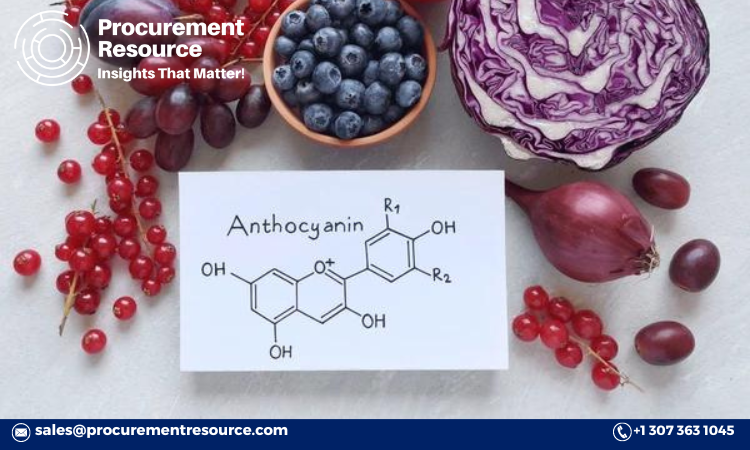
Anthocyanins are naturally occurring pigments responsible for the vibrant red, purple, and blue colors in many fruits and vegetables. They belong to the flavonoid class of compounds and have garnered significant attention due to their potent antioxidant properties and potential health benefits. The demand for anthocyanins has been on the rise, driven by their applications in the food and beverage industry, pharmaceuticals, and cosmetics. This blog delves into the intricate process of anthocyanin production, offering insights into the manufacturing process, raw material costs, and the latest developments in the field.
Manufacturing Report and Process
Extraction Methods
The production of anthocyanins primarily involves the extraction of these pigments from natural sources such as berries, grapes, red cabbage, and black rice. Several extraction methods are employed to isolate anthocyanins, including:
Request For Sample: https://www.procurementresource.com/production-cost-report-store/anthocyanin/request-sample
- Solvent Extraction: This is the most common method where solvents such as ethanol, methanol, or water are used to extract anthocyanins from plant materials. The choice of solvent significantly influences the yield and purity of the extracted anthocyanins.
- Ultrasound-Assisted Extraction (UAE): This method uses ultrasonic waves to enhance the extraction process. It is known for its efficiency and ability to reduce extraction time and solvent usage.
- Microwave-Assisted Extraction (MAE): Microwaves are used to heat the solvent and plant material mixture, facilitating the release of anthocyanins. MAE is recognized for its rapid extraction process and higher yields compared to conventional methods.
- Supercritical Fluid Extraction (SFE): This advanced technique uses supercritical CO2 as a solvent, offering a green and efficient method to extract anthocyanins without leaving toxic residues.
Purification and Concentration
Post-extraction, the crude anthocyanin extract undergoes purification and concentration processes to enhance its quality and usability:
- Filtration: The extract is filtered to remove insoluble impurities.
- Centrifugation: This process helps in separating the anthocyanin-rich phase from other plant components.
- Column Chromatography: Used for further purification, this method separates anthocyanins based on their affinity to the stationary phase in the column.
- Lyophilization: Also known as freeze-drying, this process is used to concentrate and stabilize the purified anthocyanins by removing water content.
Quality Control
To ensure the quality and efficacy of anthocyanins, rigorous quality control measures are implemented:
- HPLC (High-Performance Liquid Chromatography): This technique is employed to analyze the purity and composition of the anthocyanin extract.
- Spectrophotometry: Used to measure the concentration of anthocyanins by analyzing their absorbance properties.
- Microbiological Testing: Ensures the extract is free from microbial contamination.
Raw Material Costs
The cost of raw materials significantly impacts the overall production cost of anthocyanins. The primary raw materials include:
- Plant Sources: Fruits and vegetables rich in anthocyanins such as blueberries, blackberries, red cabbage, and black rice are the primary sources. The cost varies based on seasonality, availability, and geographic location.
- Solvents: Ethanol, methanol, and water are commonly used solvents. Ethanol is preferred due to its lower toxicity, but its cost is higher compared to methanol.
- Utilities and Chemicals: Costs associated with electricity, water, and chemicals used in extraction and purification processes also contribute to the overall production cost.
Cost Analysis
- Harvesting and Transportation: The cost of harvesting and transporting plant materials to the production facility.
- Extraction and Purification: Expenses incurred in the extraction and purification processes, including the cost of solvents, utilities, and labor.
- Quality Control: Costs related to quality control measures such as HPLC, spectrophotometry, and microbiological testing.
- Packaging and Storage: Expenses for packaging and storing the final anthocyanin extract to ensure stability and longevity.
Latest News
Innovations in Extraction Technologies
Recent advancements in extraction technologies have significantly improved the efficiency and sustainability of anthocyanin production. For instance, the development of enzyme-assisted extraction methods has shown promise in increasing yields while reducing solvent usage. Researchers are also exploring the use of green solvents and biodegradable materials to minimize the environmental impact of the extraction process.
Health Benefits and Market Demand
The health benefits of anthocyanins continue to drive market demand. Studies have highlighted their potential in preventing chronic diseases such as cardiovascular diseases, diabetes, and cancer. This has led to an increase in the incorporation of anthocyanins in functional foods, dietary supplements, and nutraceuticals.
Regulatory Approvals and Standards
The regulatory landscape for anthocyanin production is evolving, with stringent quality standards being implemented to ensure consumer safety. Regulatory bodies such as the FDA and EFSA are setting guidelines for the use of anthocyanins in food and pharmaceuticals, which has implications for producers regarding compliance and quality assurance.
Market Trends
The global anthocyanin market is experiencing robust growth, driven by increasing consumer awareness of natural and healthy products. The food and beverage industry remains the largest consumer, with significant demand for natural colorants. The cosmetic industry is also witnessing a surge in the use of anthocyanins in skincare products due to their antioxidant properties.
Industry Collaborations and Research
Collaborations between industry players and research institutions are fostering innovation in anthocyanin production. Joint ventures and partnerships are focusing on developing sustainable extraction methods and exploring new applications of anthocyanins in various industries.
Future Prospects
The future of anthocyanin production looks promising, with continuous research and development aimed at optimizing extraction processes and expanding the applications of anthocyanins. The increasing preference for natural and organic products is expected to further propel the market growth, making anthocyanin production a lucrative industry in the years to come.
Conclusion
The production of anthocyanins is a complex process involving multiple extraction, purification, and quality control steps. With the rising demand for natural pigments and the growing awareness of their health benefits, the anthocyanin market is poised for significant growth. Advances in extraction technologies and sustainable practices are set to enhance the efficiency and environmental footprint of anthocyanin production, making it a vital component of the food, pharmaceutical, and cosmetic industries. As regulatory standards become more stringent, producers will need to focus on quality assurance and compliance to meet market demands and ensure consumer safety.






